
Alu sandwich sheets in custom cut
Aluminium composite panels are very rigid and stable. The composite structure consists of aluminium layers in 0.25 mm thickness on both sides with a polyethylene (PE) core. The total thickness of these panels is 3mm. The surfaces are lacquered and covered both sides with a protective film which can easily be peeled off.
- Aluminium sandwich panels offer high rigidity at a low specific weight
- Aluminium sandwich panels are weather-resistant as well as resistant against chemicals
- Our aluminium composite panels comply with the European Union RoHS guidelines
Aluminium composite panels white 3mm
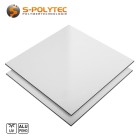 from €26.23 / m2
from €26.23 / m2Incl. 19% Tax
Aluminium composite panels anthracite 3mm
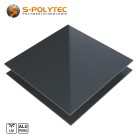 from €26.23 / m2
from €26.23 / m2Incl. 19% Tax
Aluminium composite panels dusty grey 3mm
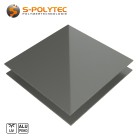 from €26.23 / m2
from €26.23 / m2Incl. 19% Tax
Aluminium composite panels black 3mm
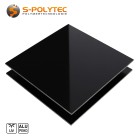 from €26.23 / m2
from €26.23 / m2Incl. 19% Tax
Aluminium composite panels silver 3mm
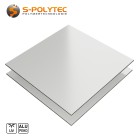 from €26.23 / m2
from €26.23 / m2Incl. 19% Tax
Aluminum composite panels brushed 3mm
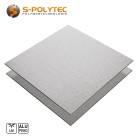 from €34.48 / m2
from €34.48 / m2Incl. 19% Tax
Buy aluminium composite panels cut to size online at low prices
Excellent quality ✓ Wide range of colours ✓ Perfect cuts ✓
In our online shop, we offer aluminium composite panels in a thickness of 3mm in various colours and designs, cut to size with millimetre precision at low prices. Depending on the colour, the surfaces of the panels are either matt on both sides or matt on one side and glossy on the other. We also offer aluminium composite panels with a brushed texture or a fine metallic effect.
What are aluminium composite panels?
Aluminium composite panels are panels manufactured in a sandwich construction from aluminium and plastic. They are produced in a special extrusion process. This process binds the aluminium cover layers inseparably to the plastic core, which is usually made of polyethylene (PE). Aluminium composite panels are often referred to by the brand name AluDibond®. The abbreviations ACP (aluminium composite panels) and ACM (aluminium composite materials) are also very common. The combination of aluminium and plastic creates a synergy between the individual material properties, which gives the aluminium composite panels enormous rigidity. Thanks to the polyethylene core, the panels are significantly lighter than solid aluminium panels of the same thickness. Another advantage of the sandwich construction is that it is easier to process than panels made entirely of aluminium.
Aluminium composite panels are available in a wide variety of designs. They come in different thicknesses, which are mainly determined by the thickness of the plastic core. The aluminium cover layers are 0.1–0.35mm thick, depending on the quality of the panels. The thicker the cover layer, the better the quality of the composite panels. In addition, the inherent rigidity and stability of the sheets increase with the thickness of the aluminium layers. This is an important aspect, not least for larger sheet formats. The cover layers of our aluminium composite panels are approximately 0.30mm thick.
In their original form, composite panels have a typical aluminium-coloured surface. However, aluminium composite panels are available in almost all colours and designs. From white and black to coloured panels in the RAL colour system, to colours with a metallic effect or in a wood finish, almost every wish can be fulfilled. Textured surfaces, such as our composite panels in brushed aluminium with a high-quality stainless steel look, are also available for aluminium composite panels. To ensure that the colour remains permanent and does not fade even under constant weather conditions, the surfaces are baked in several layers and sealed with a clear lacquer. This makes the coloured aluminium composite panels not only suitable for outdoor use, but also resistant to impact and scratching.
Note:All aluminium composite panels we offer are weatherproof and have a black core made of solid polyethylene, which is visible at the cut edges.
Our product range for aluminium composite panels in cut-to-size formats
- Aluminium composite panels with ash wood finish, 3mm thick, cut to size up to 1500mmx1000 mm
- Aluminium composite panels, brushed aluminium (similar to Butlerfinish®) in 3 mm thickness, cut to size up to 1500mmx1000mm
- Aluminium composite panels, white (similar to RAL 9003, signal white) in 3mm thickness, cut to size up to 1500mmx1000 mm
- Aluminium composite panels, dust grey (according to RAL 7037), 3mm thick, cut to size up to 1500mmx1000 mm
- Aluminium composite panels, anthracite (similar to RAL 7016, anthracite grey) in 3mm thickness, cut to size up to 1500mmx1000mm
- Aluminium composite panels, black (similar to RAL 9005, deep black) in 3 mm thickness, cut to size up to 1500mmx1000 mm
- Aluminium composite panels, silver (similar to RAL 9006, white aluminium) in 3 mm thickness, cut to size up to 1500 mmx1000mm
Our extended product range on request
- Aluminium composite panels from the standard product range in formats up to 3050mmx1500mm
- Coloured aluminium composite panels with a thickness of 3 mm in standard format or made to measure
- Aluminium composite panels with special decorative surfaces as whole panels
- Milled parts in custom shapes according to your design drawings
- and much more
How can I order aluminium composite panels cut to size online?
Buy your aluminium composite panels cut to size in the formats you need – conveniently online. You will not only benefit from outstanding quality, but also from our attractive volume discounts. Our cutting configurator for our custom-made plastic sheets is very easy to use. Simply enter the required dimensions for length and width in millimetres (not centimetres). The price is calculated in real time and automatically calculates volume discounts depending on the weight, so that you always get the best price for you.
Can I also order circles made of aluminium composite material online?
Yes, this is possible, but only on request. Thanks to our milling service, aluminium composite panels can be produced in almost any customised shape. Do you require company signs with contour milling, rounded corners, cut-outs, hole milling or similar from aluminium composite panels? Thanks to our modern panel saws, millimetre-precise cuts exactly to your specifications are no problem. With our CNC milling centres, we can also mill almost any conceivable shape for you, so that (almost) no wish remains unfulfilled.
Simply send us your enquiry with details of the colour of the aluminium composite panels, the quantity required and, for milled parts, a design drawing or sketch with dimensions. Our expert staff will then contact you immediately and send you a tailor-made quote.
We process the following formats: DXF, DWG, STEP or IGES. We are also able to convert AI and EPS files.
How are the aluminium composite panels delivered?
Your cut-to-size aluminium composite panels are usually delivered within 3-4 working days of receiving your order. The panels are normally cut to size within one working day of receiving your order and are prepared for dispatch once they have passed quality control. Depending on the total weight of your order and the size of the cut-to-size product, it will be shipped as a parcel by a parcel service provider or on a pallet by our partner shipping company. As soon as we have registered the goods for shipment, you will receive an email from the relevant shipping service provider with a tracking number. Please note that shipping may take 1-2 days from the time the goods are handed over to the shipping company.
Before your order is handed over to shipping, all your cut pieces are checked to ensure they comply with the cutting tolerances. Only when all items in your order have passed the quality check is your order carefully and securely packaged and registered for collection and shipping. For the sake of the environment, we only use packaging materials that can be completely recycled. For example, sturdy cardboard boxes made from recycled paper.
Note:To protect the surfaces from damage, all our aluminium composite panels are covered on both sides with a protective film that can be easily removed.
Where are aluminium composite panels used?
Aluminium composite panels are characterised by their enormous rigidity and comparatively low weight. Thanks to their UV and weather resistance, the panels are also ideal for outdoor use and can withstand adverse weather conditions, frost and UV radiation for many years. This is particularly beneficial in the construction sector, where the stable panels are used as weatherproof cladding for façades and living spaces. The robust panels are also used on balconies as privacy screens or partition walls and are an inexpensive alternative to HPL panels. In addition, roofers often use the panels as edging for flat roofs or as cladding for the underside of roof overhangs. Aluminium composite panels are also used in window construction. For example, as cladding for roller shutter boxes or as weatherboards for windows and doors.
However, aluminium composite panels are not only used outdoors. In kitchens in particular, the panels with their attractive surface are used as an alternative to conventional tile backsplashes, as aluminium composite panels are very easy to clean. The waterproof panels are also a beautiful alternative to tiles in bathrooms. For example, as wall cladding in shower enclosures.
Another very common use for aluminium composite panels is in advertising technology. From perimeter advertising for local football clubs, to advertising signs and information boards for companies, to company lettering in contour milling. The lightweight and stable sandwich panels are also frequently used in trade fair construction. The signs are often laminated with film, labelled using a plotter or digitally printed to achieve attractive and eye-catching advertising. Many agencies and print shops also offer their services to private customers, printing decorative wall designs with large-format images on aluminium composite panels. This is done either by printing directly onto the panel or by printing onto a self-adhesive digital printing film, providing an attractive and unusual alternative to printed images on canvas.
In vehicle construction, aluminium composite panels are used, for example, in the manufacture of box bodies for trailers and trucks or for interior panelling in delivery vans due to their low weight.
Typical examples of the use of aluminium composite panels
- In advertising technology, aluminium composite panels are used for perimeter advertising, company signs or in trade fair construction
- In vehicle construction, the lightweight, stable panel is used for trailer bodies or interior panelling
- In the construction sector, the weatherproof panels are used as façade panels or balcony cladding
- Aluminium composite panels are often used as an alternative to large-format printing on canvas for wall decoration
- Aluminium composite panels are easy to maintain and are often used as an alternative to tiles in kitchens and bathrooms
- Aluminium composite panels are used in window construction as window profiles, weatherboards and door leaves for front doors
- und viele weitere mehr
Physical properties of aluminium composite panels
Our aluminium composite panels with a thickness of 3mm consist of two approx. 0.2mm-0.3mm thick aluminium cover layers (depending on the colour of the aluminium composite panels) and a black polyethylene core. These sandwich panels, with a physical density of approx. 1.3 g/cm³3, offer enormous rigidity and stability despite their comparatively low weight.
Aluminium composite panels have high bending strength and break resistance and are extremely resistant to chemicals. Furthermore, our aluminium composite panels are UV and weather resistant. This makes the weatherproof panel ideal for permanent outdoor use. With a temperature range of -40°C to +80°C, the panels are frost-resistant and can also withstand high summer temperatures with strong sunlight.
The thermal expansion is just one tenth of that of normal plastic panels. This makes these panels ideal for cladding large areas, for example to enhance the appearance of façades thanks to their aesthetic look or the double-sided coating of the surfaces.
- Physical density: 1.30 - 1.32 g/cm ³
- Operating temperatures: -40 °C to +80 °C
- Fire behaviour: normally flammable DIN 4102 B2
- UV resistance: Yes
- Weather resistance: Yes
- Water resistance: Yes
- Frost resistance: Yes
- Corrosion resistance: Yes
- Food safe: No
Note:Detailed information on the physical and thermal properties of our aluminium composite panels can be found in the detailed product description and the corresponding data sheets.
Processing of our aluminium composite panels
How to cut aluminium composite panels?
Our aluminium composite panels can be cut using simple tools. For example, cut-outs or radii can be created very easily with a jigsaw. For straight cuts, we recommend using a hand-held circular saw, as this is the best way to ensure that the saw cuts are straight. Due to the aluminium cover layers on both sides, a fine-toothed saw blade for metal should be used. However, the speed and feed rate should be set in the middle range, similar to our plastic sheets, to prevent the PE core of the sandwich sheets from melting.
CNC milling is another way of cutting the aluminium composite panels to the desired size. Unlike sawing, milling offers significantly more flexibility in terms of shaping and, in addition to cut-outs, also allows the aluminium cover layers to be engraved, exposing the black polyethylene core.
However, due to their low strength, blanks can also be cut using punching or water jet cutting. However, special equipment is required for this.
Warning:Cutting with a CO2 laser is not easily possible and requires a special laser unit with sufficient power.
How to drill aluminium composite panels?
We recommend using a metal drill bit for drilling aluminium composite panels. When drilling, the panels should be placed on a flat surface to prevent the 3 mm thick panels from bending under pressure. Due to the hard, smooth aluminium surface, the drill holes should be pre-marked with a scriber or centre punch. This prevents the drill from slipping and ensures precise positioning of the drill holes. Alternatively, a drill bit with a ground centring tip can be used. Drill holes used for fastening should always be 2 mm larger than necessary, except for one fixed point. This prevents the panels from deforming due to thermal expansion at rising temperatures.
TIP:With our CNC milling machines, we can cut your composite panels into any shape and also drill precise holes for assembly.
How to install aluminium composite panels?
Aluminium composite panels can be installed indoors and outdoors in a variety of ways. As façade panels or wall cladding, for example, they can be installed by gluing or screwing them directly to the substrate. In addition, installation with stainless steel or aluminium spacer sleeves is common practice and is used primarily for lettered advertising signs to achieve a more attractive appearance. Riveting to a metal substructure with rivets in the appropriate colour, as well as connecting the sandwich panels to each other, is another widely used method for installing aluminium composite panels. Temperature fluctuations are completely normal outdoors. Therefore, care should be taken during installation to ensure that the panel can still expand without any problems after it has been fixed in place. This process is called constraint-free installation.
Can aluminium composite panels be bent?
Our sandwich panels are extremely rigid, but can be bent to a certain extent due to their low thickness of 3mm. However, a bending device should be used to achieve a precise bending radius. A folding machine is recommended for folding at a specific angle. By milling grooves with a conical milling head, the rigid aluminium composite panels can also be bent at a perfect right angle. This is particularly useful for weather boards on windows or flat roofs. Bending should then be carried out with care. It is advisable to heat the surface with a hot air gun, as this significantly reduces the risk of the thin decorative surface cracking.
WARNING:If aluminium composite panels are bent or folded, this cannot be reversed without negatively affecting the appearance of the surface.
Can aluminium composite panels be glued?
When bonding aluminium composite panels, the intended use is important. For large-area bonding as façade panels or wall cladding, a powerful assembly adhesive such as our MS polymers is most suitable. This adheres to the aluminium top layer as well as to almost all substrates found in the construction sector, such as tiles, concrete, sand-lime brick, wood or plasterboard. A popular example of this is a jointless shower back wall, where the entire shower enclosure is covered on each side with a single panel over the entire surface. An MS polymer is also very well suited for bonding the composite panels to each other or for sealing edges and corners when the panels are used as wall cladding in outdoor areas, bathrooms or damp rooms, for example. Solvent-based adhesives are not recommended, as the solvent has no effect on aluminium and cannot dissolve the metal surface. Instead, the solvent can attack the paintwork. Our two-component adhesive Plexus MA300 can be used to bond metals to each other or to plastics, so we recommend this adhesive for smaller bonding jobs or for manufacturing housings by bonding. Our plastic adhesives Ruderer L530 or Technicoll 8008 are also very well suited for bonding aluminium composite panels to a wide variety of materials.
Can aluminium composite panels be printed on?
Printing on aluminium surfaces is no problem at all. Various printing methods are available for this purpose, such as screen printing or direct printing using digital printing. Direct printing in particular allows digital photos to be printed onto the surfaces with little effort, creating high-quality wall pictures with an attractive appearance for decorative purposes. However, this usually requires special plate printers, such as those used in large print shops or advertising agencies. Our white aluminium composite panels are best suited for printing, as their neutral surface does not distort the colour effect. Brushed aluminium surfaces with a stainless steel look are also frequently used to achieve a special effect. A good example is the artist Kev Munday from Great Britain, who prints his colourful works in digital print on brushed aluminium composite panels. This gives black and white images in particular a very special look with a high-quality surface feel. Transparent acrylic glass panels are often used to protect the printed surface or to enhance the depth effect of the prints.
As an alternative to printing directly onto the panel surface, digital prints can be printed onto a self-adhesive film. This is then bonded to the aluminium cover layer. Depending on the intended use, a protective laminate is applied to prevent the ink from fading due to ultraviolet radiation. This process is particularly popular for large-format advertising signs, as it not only offers maximum flexibility but is also usually significantly cheaper than comparable direct printing.
Environmental compatibility of aluminium composite panels
The sandwich-construction panels are weatherproof and therefore extremely durable. Even in permanent outdoor use, UV radiation, rain or frost do not affect the high-quality appearance, so the panels do not need to be replaced or renewed at regular intervals. Aluminium composite panels do not decompose and are corrosion-resistant. This means that aluminium composite panels can rightly be classified as very environmentally friendly. If the weatherproof panels are no longer required, they can be disposed of at a recycling centre and thus recycled properly.
Dibond® and Butlerfinish® are registered trademarks of 3A Composites Holding AG.